Corkscrew Sanctuary – Every Visit is Different
I’ve visited Corkscrew Sanctuary in SW Florida at least a dozen times over the past thirty years and I’m always amazed at how completely different each visit is from the past ones. On one visit the water might be high and there will be wildlife everywhere, while on another it might be low and instead of photographing birds and gators I might be photographing rare native Florida orchids. Sometimes it’s almost as quiet as a church and other times so raucous you’d think you were in the Amazon. Mostly, though it’s a combination of both extremes. There’s always great birdlife, almost always gators and sometimes a real surprise like a bobcat or an otter; some have even seen the elusive Florida panther. The one thing that I hope will never change is the world’s largest old growth bald cypress forest. These trees are so old, so large and each so unique that, like sequoias in California, many have their own names. Won’t you join Alison and me as we visit Corkscrew Sanctuary once again?
What and Where is Corkscrew Sanctuary?
The proper name is Corkscrew Swamp Sanctuary and it’s a huge piece of land, 17 sq. miles (45 sq. kms.) in SW Florida not far from the cities of Naples and Bonita Springs. Administered by the Audubon Society since 1955, it preserves not only the old growth bald cypress swamp, but a number of other Florida ecosystems including a wet prairie (not an oxymoron) and a pond cypress forest. Since all of these environments are usually wet or muddy, just getting out and walking through them is neither possible or advisable (alligators and poisonous snakes abound). The great attraction of Corkscrew Sanctuary is its almost two mile (3 km.) boardwalk that takes visitors in a circular route through four distinct environments in a visit that can last all day if you are a serious birder or photographer. It’s simply one of the great short wildlife walks in the world. BTW it’s fully handicap accessible and has options to take shortcuts if you aren’t up to going the entire distance. On most visits the best viewing is at the Lettuce Lakes which can be reached quickly via the shortcut.
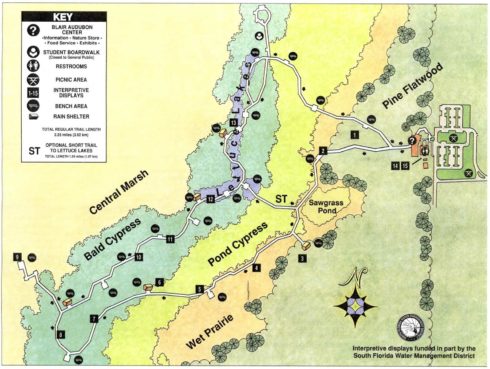
Getting to Corkscrew is easy. It’s well signed off Interstate 75 just north of Naples. Admission is $14.00 for adults, but much cheaper for students and children. Believe me, it’s worth it. The visit starts at the Blair Audubon Visitor Center where you can learn a lot about Corkscrew Sanctuary, but honestly, it’s all about the boardwalk. So let’s go, but first make sure you have binoculars. If you don’t you can rent them at the center. Bug spray, sunscreen, water and cameras are the other necessities. About the bugs – sometimes they are non-existent, other times they are persistent. You never know. Be prepared.
Whether you are new to birding or a veteran, you might want to consider joining one of the guided tours that are led by volunteers who not only love their jobs, but will definitely point out more than you’ll ever see on your own. We just missed the 8:00 departure so today we are on our own.
Walking the Boardwalk
At the entrance to the boardwalk there is a blackboard where visitors who have completed the walk write down any new sitings. We’re here early so there are only a few, but include painted and indigo buntings, two of the most colourful songbirds in North America. Hopefully, we can add a few of our sitings after we are through.
Speaking from experience, the first part of the walk is the least exciting as it passes through a pine forest not unlike that found in many Florida state parks. However, like Will Rogers who never met a man he didn’t like, I’ve never walked through a pine forest I didn’t like. Just the smell or better said, resinous aroma, of a pine forest is reason enough to walk through one. Next, the pine trees come abruptly to an end and there is a short section through a wet prairie. Since it’s late March and well into the dry season there is no water under the boardwalk and the grass is tinder dry, but there’s enough moisture in the soil for blue flag and swamp lilies to bloom.
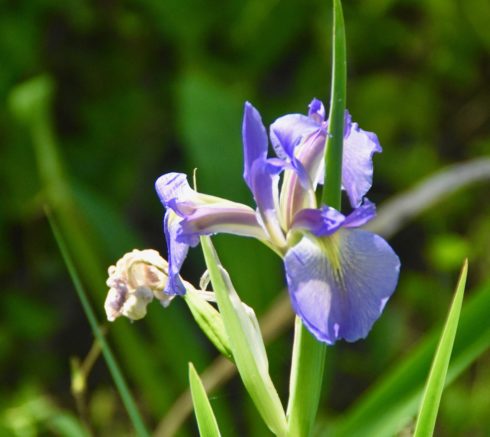
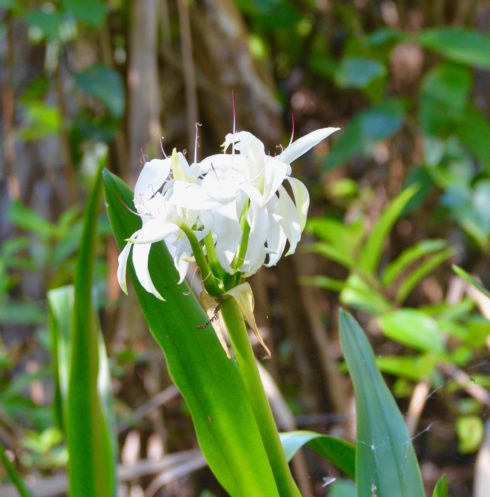
Again there is an abrupt change between ecosystems from the wet prairie to the pond cypress forest. There are two types of cypress in Florida, the bald and the pond and like the three types of mangrove, they inhabit distinctly separate types of soil. The pond cypress is much smaller than the bald, although it can grow as high as almost sixty feet which is still pretty impressive. Both types share the trait of shedding their needles in winter and regrowing them in the spring and the needles on these cypress are very fresh and green, in sharp contrast to the umber tones of the prairie we just left.
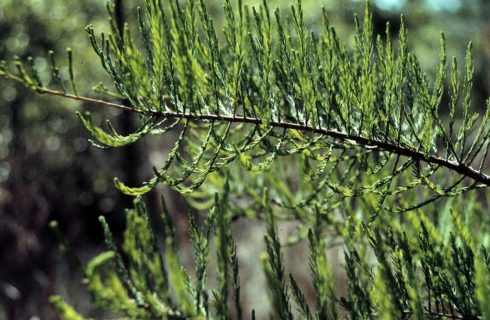
Not long after entering the pond cypress forest we catch up to one of the guided tours which has stopped to observe a mixed flock of small songbirds that is flitting all around the trees and undergrowth. At a glance I can identify parula and black and white warblers, Carolina wrens and blue-gray gnatcatchers, but getting a decent picture of these hyper active birds is impossible despite ten minutes of trying. Moving on we come to a sight we’ve never seen before in Corkscrew Sanctuary.
There’s an oval ball of fluff sitting high in one of pond cypress that can only be a Barred Owlet. Not surprisingly it has drawn a crowd.
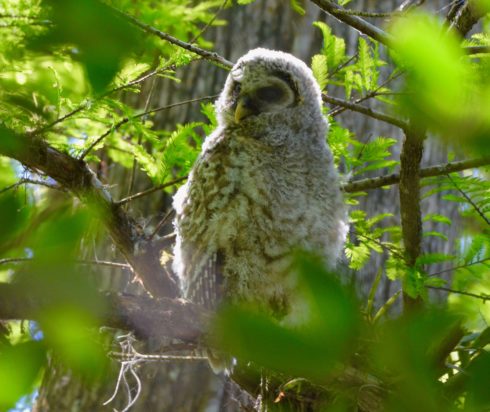
In a nearby tree an unattendent parent bird seems to be fast asleep. This would be a good sighting even without the owlet.
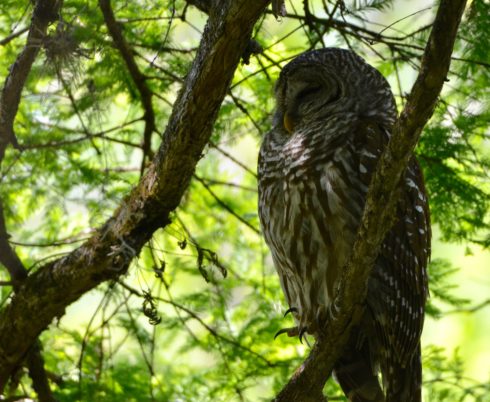
While Mom or Dad sleeps, the owlet looks right at us, bobs up and down and then almost falls off the branch which would be a disaster as it can’t yet fly.
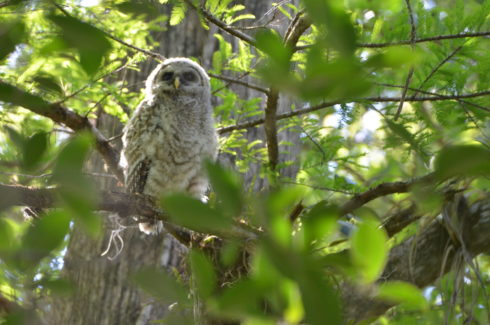
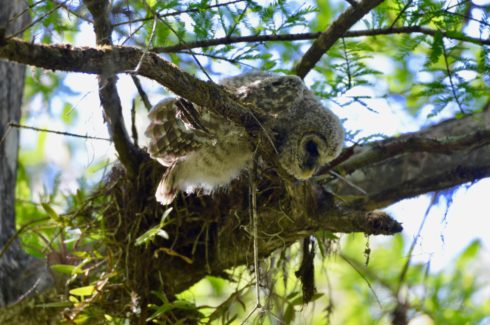
These near fatal aerial antics draw gasps from the crowd below, but the owlet soon rights itself and I can only hope it makes it through the next few weeks before it becomes a full-fledged nocturnal predator on its own.
Next we enter the bald cypress forest, which is the primary reason that Corkscrew Sanctuary was created in the 1950’s. These are among the largest and most majestic trees in all the U.S. Unfortunately, like the white pine forests of the northeast, the bald cypress forests where all but wiped out by loggers eager to harvest the thousands of board feet that one tree can produce. What we are entering today is the largest remaining remnant of a forest that once covered hundreds of square miles in southern Florida. Bald cypress can live for six hundred years and grow well over 100 feet tall and there are many specimens in Corkscrew Sanctuary that were alive when Columbus arrived in the New World. They also prefer much wetter conditions than the pond cypress and on every tree you can see a line marking the high water point that will be reached during the summer rainy season.
The Lettuce Lakes at Corkscrew Sanctuary
Even though it is the dry season there is still some water in the bald cypress forest. These are the Lettuce Lakes, so called for the water lettuce that covers most of the water’s surface. They are not lakes, but shallow ponds that at this time of year are teeming with wildlife, especially the large egrets and herons that once made this area a plume hunter’s paradise. For the sake of a lady’s hat, millions of these birds were slaughtered simply for their tail feathers or aigrets as they are properly called. The reason so many congregate here at this time of year is that the ponds are almost dried up and the small fish that once had the entire forest floor to forage in, now are stuck with just a few acres of water. They might as well be fish in a barrel.
Arriving at Lettuce Lakes I can see that the birds are here in great numbers, mostly great egrets that are constantly squabbling with each, but also five types of heron, anhingas and ibis as well. The alligators are also here in numbers.
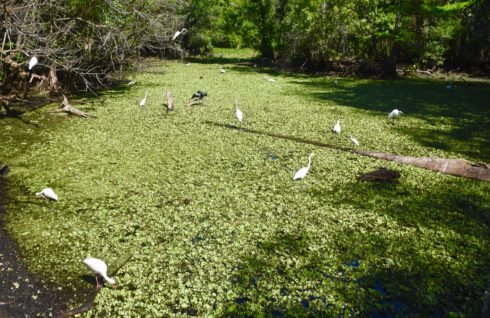
I’ve been to many places around the world to view wildlife and except maybe for some African water holes, I’ll put the Lettuce Lakes up against any of them for variety of wild life. One can spend hours here and not get bored. Time for some closeups.
As this is breeding season the great egrets are adorned with aigrets and as Billy Crystal would say, “Look mahvellus”. This guy reminded me of the type of robes that boxers wear when entering the ring for a prize fight.
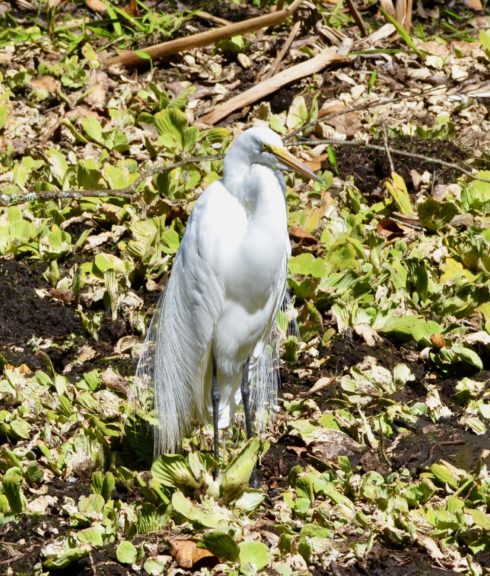
While this guy might be a white grim reaper, the way he was posed.
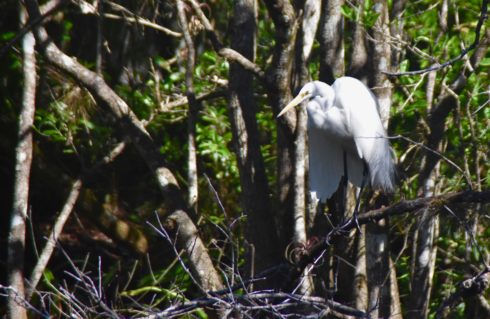
And here’s his counterpart with the wings of an angel. Can you imagine shooting one of these birds?
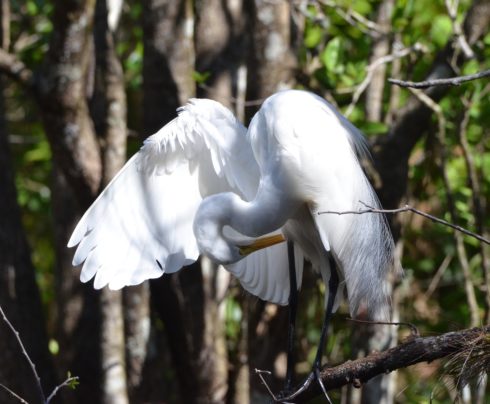
This great blue heron had just caught himself a small fish.
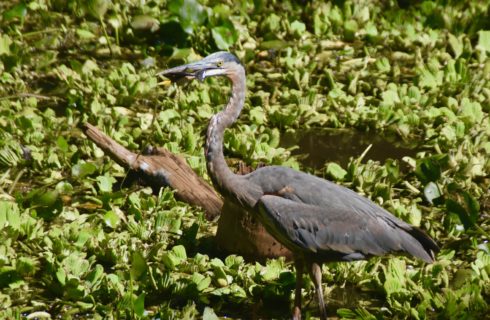
Now ordinarily a great blue could swallow a fish ten times as big as this guy, but for some reason he had tremendous difficulty getting it down. I later saw a great egret having the same problem. I don’t know if it was the type of fish or if it was some kind of spring ritual, but it was fun to watch, unless you were the fish.
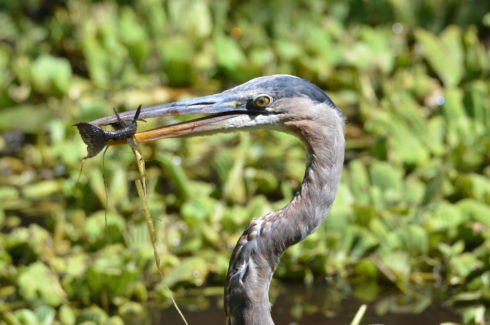
The pond’s resident anhinga did his hunting under the water lettuce and came up with his lunch.
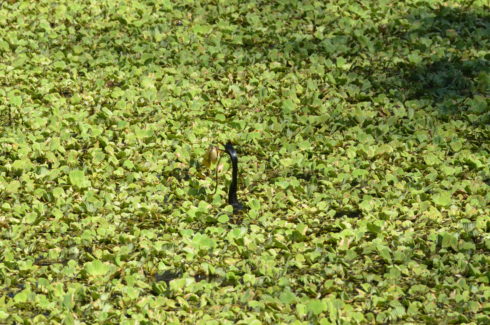
Unlike the heron and egret, he had no problem wolfing his down, weeds and all..
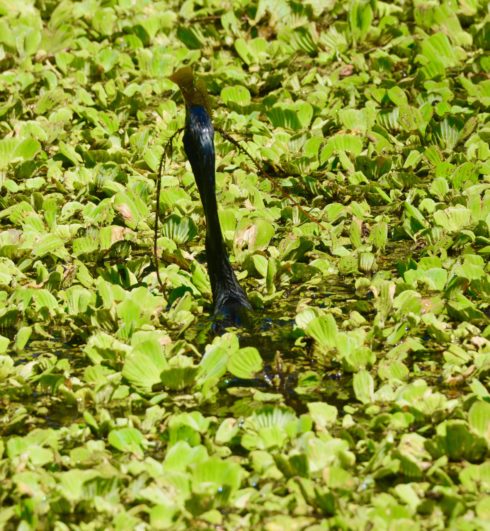
Later the anhinga climbed onto a tree branch to dry out his wings and pose for the photographers.
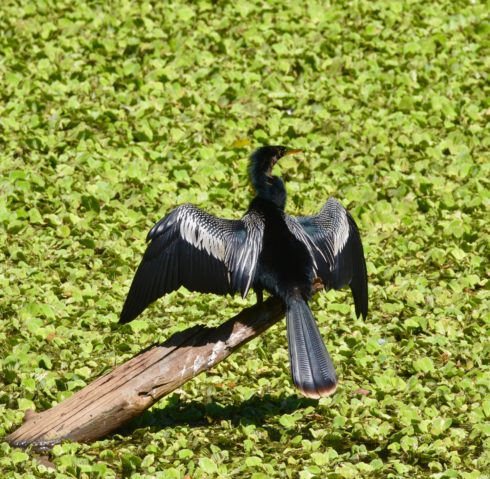
Here’s a little blue heron poised for action.
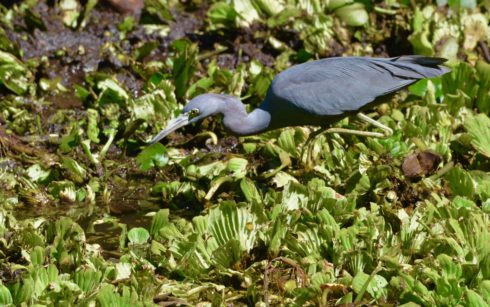
Does he know how close he is to a big mother alligator?
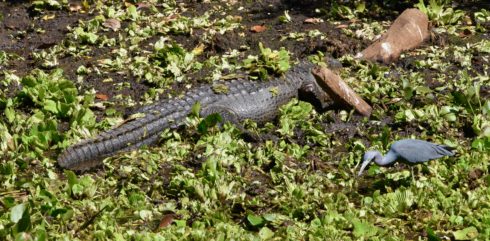
She’s guarding a passel of different sized baby alligators only a few yards away.
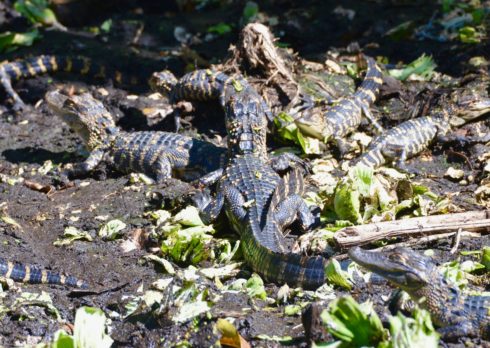
The one bird we did not see today was a wood stork. They are denizens of the bald spruce forest and nest here. At one time almost extinct because their habitat was almost wiped out, the wood stork has made a tremendous recovery. I saw one last year as far north as Kiawah Island, South Carolina. Here’s a photo taken at Lettuce Lake a year ago when it was full of wood storks.
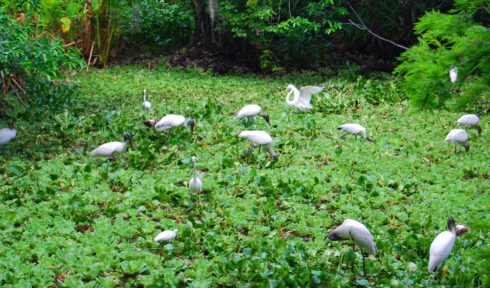
After looking down to stifle a laugh when a guy, who had to be at least forty, asked me if the great egret were flamingos, I spotted a water moccasin curled up in a hole in a rotting tree that had fallen into the pond. I resisted the urge to reply, “No, they’re penguins.” and told him what they were. How do you get to be forty and not know what a flamingo looks like? Anyway, here’s Mr. Moccasin, just catching some rays. He better hope one of the red-shoulder hawks that frequent the swamp or the barred owl we saw, doesn’t spot him or he’ll wish he’d stayed hidden.
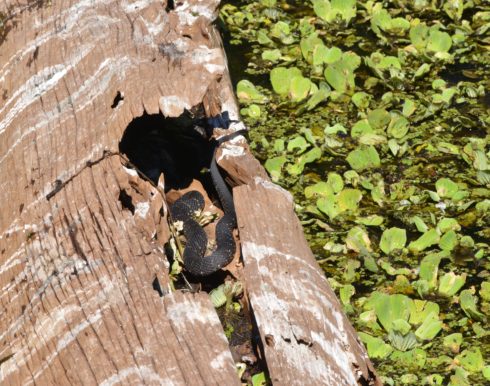
We concluded our walk on the Corkscrew Sanctuary back at the blackboard at the entrance and noticed that the number of sightings had tripled at least, but no one had put down water moccasin, so we added our own small contribution to today’s sightings. I hope this post inspires you to want to visit Corkscrew Sanctuary and remember, there’s no bad time to visit and every visit is different.
If you enjoy wildlife watching, but can’t get to Corkscrew Sanctuary, Six Mile Cypress Slough right in Fort Myers which can be reached by public transportation or bike is a very acceptable alternative.

